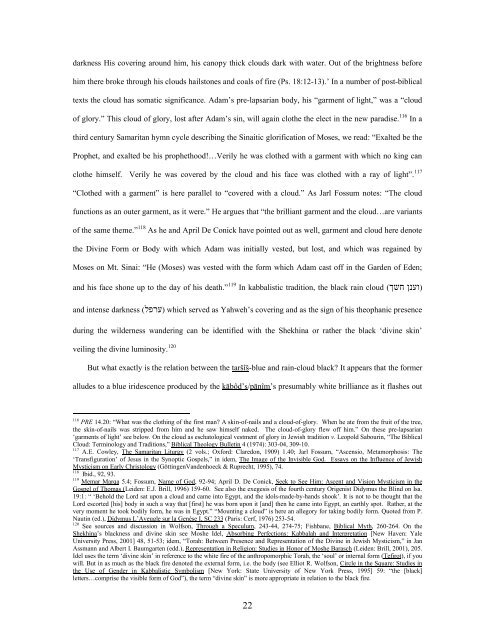Sapphiric God: - Dr. Wesley Muhammad
Sapphiric God: - Dr. Wesley Muhammad
Sapphiric God: - Dr. Wesley Muhammad
You also want an ePaper? Increase the reach of your titles
YUMPU automatically turns print PDFs into web optimized ePapers that Google loves.
darkness His covering around him, his canopy thick clouds dark with water. Out of the brightness before<br />
him there broke through his clouds hailstones and coals of fire (Ps. 18:12-13).’ In a number of post-biblical<br />
texts the cloud has somatic significance. Adam’s pre-lapsarian body, his “garment of light,” was a “cloud<br />
of glory.” This cloud of glory, lost after Adam’s sin, will again clothe the elect in the new paradise. 116 In a<br />
third century Samaritan hymn cycle describing the Sinaitic glorification of Moses, we read: “Exalted be the<br />
Prophet, and exalted be his prophethood!…Verily he was clothed with a garment with which no king can<br />
clothe himself. Verily he was covered by the cloud and his face was clothed with a ray of light”. 117<br />
“Clothed with a garment” is here parallel to “covered with a cloud.” As Jarl Fossum notes: “The cloud<br />
functions as an outer garment, as it were.” He argues that “the brilliant garment and the cloud…are variants<br />
of the same theme.” 118 As he and April De Conick have pointed out as well, garment and cloud here denote<br />
the Divine Form or Body with which Adam was initially vested, but lost, and which was regained by<br />
Moses on Mt. Sinai: “He (Moses) was vested with the form which Adam cast off in the Garden of Eden;<br />
and his face shone up to the day of his death.” 119 In kabbalistic tradition, the black rain cloud (ךשח ןנעו)<br />
and intense darkness (לפרע) which served as Yahweh’s covering and as the sign of his theophanic presence<br />
during the wilderness wandering can be identified with the Shekhina or rather the black ‘divine skin’<br />
veiling the divine luminosity. 120<br />
But what exactly is the relation between the taršîš-blue and rain-cloud black? It appears that the former<br />
alludes to a blue iridescence produced by the kābôd’s/pānîm’s presumably white brilliance as it flashes out<br />
116 PRE 14.20: “What was the clothing of the first man? A skin-of-nails and a cloud-of-glory. When he ate from the fruit of the tree,<br />
the skin-of-nails was stripped from him and he saw himself naked. The cloud-of-glory flew off him.” On these pre-lapsarian<br />
‘garments of light’ see below. On the cloud as eschatological vestment of glory in Jewish tradition v. Leopold Sabourin, “The Biblical<br />
Cloud: Terminology and Traditions,” Biblical Theology Bulletin 4 (1974): 303-04, 309-10.<br />
117 A.E. Cowley, The Samaritan Liturgy (2 vols.; Oxford: Claredon, 1909) 1.40; Jarl Fossum, “Ascensio, Metamorphosis: The<br />
‘Transfiguration’ of Jesus in the Synoptic Gospels,” in idem, The Image of the Invisible <strong>God</strong>. Essays on the Influence of Jewish<br />
Mysticism on Early Christology (GöttingenVandenhoeck & Ruprecht, 1995), 74.<br />
118 Ibid., 92, 93.<br />
119 Memar Marqa 5.4; Fossum, Name of <strong>God</strong>, 92-94; April D. De Conick, Seek to See Him: Ascent and Vision Mysticism in the<br />
Gospel of Thomas (Leiden: E.J. Brill, 1996) 159-60. See also the exegesis of the fourth century Origenist Didymus the Blind on Isa.<br />
19:1: “ ‘Behold the Lord sat upon a cloud and came into Egypt, and the idols-made-by-hands shook’. It is not to be thought that the<br />
Lord escorted [his] body in such a way that [first] he was born upon it [and] then he came into Egypt, an earthly spot. Rather, at the<br />
very moment he took bodily form, he was in Egypt.” “Mounting a cloud” is here an allegory for taking bodily form. Quoted from P.<br />
Nautin (ed.), Didymus L’Aveugle sur la Genèse I, SC 233 (Paris: Cerf, 1976) 253-54.<br />
120 See sources and discussion in Wolfson, Through a Speculum, 243-44, 274-75; Fishbane, Biblical Myth, 260-264. On the<br />
Shekhina’s blackness and divine skin see Moshe Idel, Absorbing Perfections: Kabbalah and Interpretation [New Haven: Yale<br />
University Press, 2001] 48, 51-53; idem, “Torah: Between Presence and Representation of the Divine in Jewish Mysticism,” in Jan<br />
Assmann and Albert I. Baumgarten (edd.), Representation in Religion: Studies in Honor of Moshe Barasch (Leiden: Brill, 2001), 205.<br />
Idel uses the term ‘divine skin’ in reference to the white fire of the anthropomorphic Torah, the ‘soul’ or internal form (Tefirot), if you<br />
will. But in as much as the black fire denoted the external form, i.e. the body (see Elliot R. Wolfson, Circle in the Square: Studies in<br />
the Use of Gender in Kabbalistic Symbolism [New York: State University of New York Press, 1995] 59: “the [black]<br />
letters…comprise the visible form of <strong>God</strong>”), the term “divine skin” is more appropriate in relation to the black fire.<br />
22
















